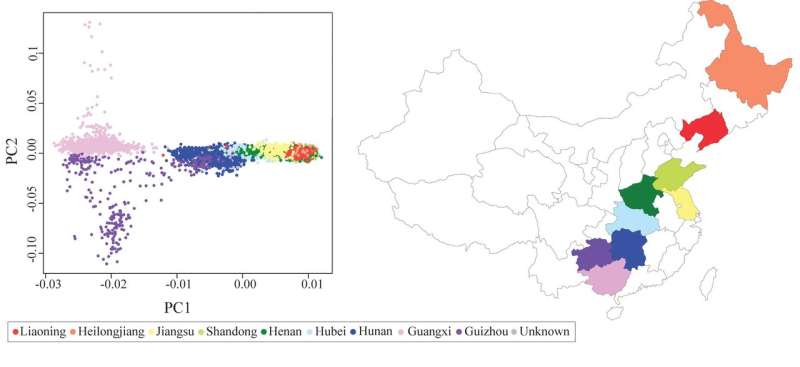Principal components analysis of allele frequency for 8,403 subjects in the China Health and Nutrition Survey. Dots representing each subject are colored by the province in which they reside. Credit: Cassandra N. Spracklen, Jinxiu Shi and colleagues
Researchers investigated genomes from diverse Chinese populations to identify new and known genetic variants that contribute to a person's blood sugar level and risk of Type 2 diabetes. Karen Mohlke at the University of North Carolina at Chapel Hill, Wei Huang at the Chinese National Human Genome Center and Shanghai Industrial Technology Institute, and their colleagues report these findings in a new study published April 5th, 2018 in PLOS Genetics.
Type 2 diabetes affects more than 422 million people worldwide and at least 30% of these cases occur in East Asian populations. A person's risk of Type 2 diabetes, as well as the levels of blood sugar, insulin and HbA1c, which gives an average of recent blood sugar levels, are all inherited traits. The genetic variants that contribute to these traits can vary between populations, so researchers conducted genome-wide association analyses to identify these variants in up to 7,178 Chinese individuals from nine provinces who participated in the China Health and Nutrition Survey (CHNS).
The study identified new variants and confirmed 32 previously described variants believed to contribute to Type 2 diabetes and blood sugar level, which vary in frequency across the population. The researchers also performed laboratory assays to show that one variant located in a gene regulatory element between the SIX2 and SIX3 genes reduces transcriptional activity and gene expression in pancreatic islets, leading to elevated blood sugar. "We compared variants linked to glucose level in East Asians with variants linked to islet gene expression levels in Europeans,"Dr. Mohlke explained. "This cross-ancestry comparison helped define a molecular mechanism that supports, in humans, a role for the SIX3 and/or SIX2 transcription factors affecting insulin secretion."
A next step in this work will be to investigate further the function of other genetic variants identified in the study to better understand how they contribute to blood sugar levels and risk of Type 2 diabetes. This work also highlights the usefulness of the diverse population within the CHNS for performing genetic studies. As researchers conduct more genome-wide meta-analyses across genetically diverse populations, they will likely identify additional genetic variants that will better explain the levels of heritability of complex traits like diabetes.
More information: Spracklen CN, Shi J, Vadlamudi S, Wu Y, Zou M, Raulerson CK, et al. (2018) Identification and functional analysis of glycemic trait loci in the China Health and Nutrition Survey. PLoS Genet 14(4): e1007275. doi.org/10.1371/journal.pgen.1007275
Journal information: PLoS Genetics
Provided by Public Library of Science






















